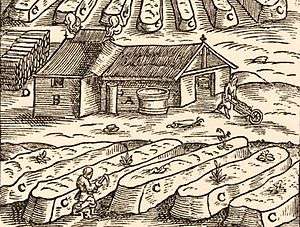Nitrary

A nitrary[1] is a place of production of potassium nitrate or saltpetre used primarily for the manufacture of gunpowder. The saltpetre occurs naturally in certain places like the "Caves of Salnitre" (Collbató) known since the Neolithic –Cova del rat penat– the guano (bat excrements) deposited over thousands of years became saltpetre after being leached by the action of meteoric water.
Manufacture
The process involved burial of excrements (human or animal) in the fields prepared for that purpose beside the nitraries, watering them and waiting until the leaching process did its job; after a certain time, operators gathered the saltpetre that "came out" to the ground surface by efflorescence. Then they transported it to be concentrated by ebullition in the boiler plant.[2][3]
History
Besides "Montepellusanus",[4] during the thirteenth century (and beyond) the only supply of saltpetre across Christian Europe (according to "De Alchimia" in 3 manuscripts of Michael Scot, 1180-1236) and has been found in Spain in Aragon in a certain mountain near the sea ... and the same hispanic they called it: alumen acetum activum " saraceni apellant ipsum borax et credunt quod sit alumen.[5] Et in Hispania invenitur versus Argoniam in quodam monte juxta mare”. et apellant ipsum hispani alumen acetum activum...[4][6]
In fact in 1561, Elizabeth I of England at war with Philip II of Spain, became unable to import the saltpetre (of which the Kingdom of England had no home production), and had to pay "300 pounds gold" to the German captain Gerrard Honrik for the manual "Instructions for making salpetre to growe" (the secret of the "Feuerwerkbuch" -the nitraries-)
See also
- Bernard Courtois, who operated a Salpetriere or nitrary and discovered iodine.
- History of gunpowder in Catalonia
- Nitrate of Chile
- Humberstone and Santa Laura Saltpeter Works
- Caliche
References
- ↑ John Spencer Bassett; Edwin Mims; William Henry Glasson; William Preston Few; William Kenneth Boyd; William Hane Wannamaker (1904). The South Atlantic Quarterly. Duke University Press. Retrieved 22 February 2013.
- ↑ Paul-Antoine Cap (1857). Etudes biographiques pour servir à l'histoire des sciences ...: sér. Chimistes. V. Masson. pp. 294–. Retrieved 23 February 2013.
- ↑ Oscar Gutman (1906). Monumenta pulveris pyrii. Repr. Artists Press Balham. pp. 50–.
- 1 2 James Riddick Partington (1960). A history of Greek fire and. JHU Press. pp. 89 –. ISBN 978-0-8018-5954-0.
- ↑ James Riddick Partington (1960). A history of Greek fire and March 2012. JHU Press. pp. 311 –. ISBN 978-0-8018-5954-0.
- ↑ Alexander Adam (1805). A compendious dictionary of the Latin tongue: for the use of public Seminar and private March 2012. Printed for T. Cachorro and W. Davies, by C. Stewart, London, Bell and Bradfute, W. Creech.
| Wikimedia Commons has media related to Niter. |